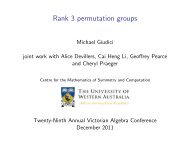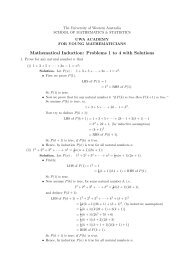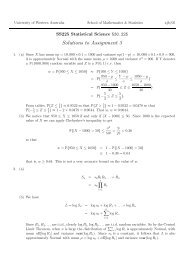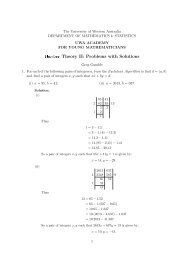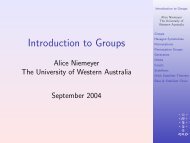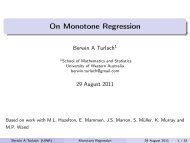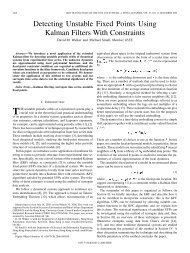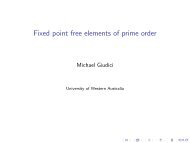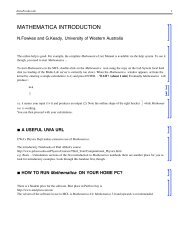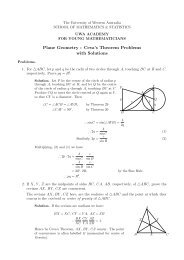Problem Sheet 2 - School of Maths and Stats Local Site - The ...
Problem Sheet 2 - School of Maths and Stats Local Site - The ...
Problem Sheet 2 - School of Maths and Stats Local Site - The ...
Create successful ePaper yourself
Turn your PDF publications into a flip-book with our unique Google optimized e-Paper software.
<strong>The</strong> University <strong>of</strong> Western Australia<strong>School</strong> <strong>of</strong> Mathematics & Statistics3OR: Operations Research<strong>Problem</strong> <strong>Sheet</strong> 2<strong>The</strong>re are 3 Assignment 1 problems(starred).Please h<strong>and</strong> your solutions to allAssignment 1 problems to me by 5pm, Friday7/9/2010.1. A company produces dressed timber(smooth rectangular section) <strong>and</strong> moldings(fancy sections).Dressed timber isproduced from rough-sawn timber, whichhas been cut to approximately the correctsize, by planing.Moldings are producedfrom dressed timber by milling. <strong>The</strong> companyhas a contract to supply 200 tonne<strong>of</strong> rough-sawn timber, 500 tonne <strong>of</strong> dressedtimber <strong>and</strong> 80 tonne <strong>of</strong> molding. <strong>The</strong> companycan either produce the timber productsitself or purchase some or all the productsfrom others suppliers. <strong>The</strong> table belowstates the internal production costs($/tonne), that is, for example, the cost<strong>of</strong> producing dressed timber from roughsawntimber, <strong>and</strong> external purchase costs($/tonne).Product Internal ExternalRough-sawn 35 60Dressed 10 75Molding 5 94Cutting Planing MillingRough-sawn 1 0 0Dressed 3 3 0Molding 2 2 3Capacity 1600 1500 1700<strong>The</strong> company has three sections for cutting,planing <strong>and</strong> milling.<strong>The</strong> table belowshows the capacity <strong>of</strong> the sections (totalproduct hours available) <strong>and</strong> processingtime required (hours/tonne) for eachproduct.(a) Write down a linear program to fulfillits contract at minimum cost.(b) Solve the linear program using s<strong>of</strong>tware.(c) Describe the optimal productionstrategy for the company. What canyou say about the internal productioncosts <strong>and</strong> capacity constraints <strong>of</strong> thiscompany? What could the companydo to reduce its operation costs onsimilar contracts?2. Western Australian company needs towork out the production schedule for manufacturings<strong>of</strong>as.Two resources, labour<strong>and</strong> material, are needed in the production.<strong>The</strong> company has designs <strong>of</strong> threedifferent models.<strong>The</strong> production engineeringdepartment has provided the followingdata:A B CLabour 7 3 6Material(kg per unit) 4 4 5Pr<strong>of</strong>its($ per unit) 4 2 3A supplier has been contracted to supplythe raw material, but with a maximum <strong>of</strong>250kg per day. <strong>The</strong> company has a labourforce <strong>of</strong> 120 hours per day. <strong>The</strong> problemfacing the company is to determine thedaily production rate <strong>of</strong> the various modelsin order to maximize the total pr<strong>of</strong>it.Formulate this decision-making problemas a linear programming problem <strong>and</strong> solvethe LP problem by s<strong>of</strong>tware.3. Formulate each <strong>of</strong> the following problemsas an integer programming problem.min z = f 1 (x 1 ) + f 2 (x 2 ) subject to the followingconstraints:(i) x 1 ≥ 10 or x 2 ≥ 10.(ii) At least one <strong>of</strong> the inequalities, 2x 1 +1
x 2 ≥ 15, x 1 + x 2 ≥ 15 <strong>and</strong> x 1 + 2x 2 ≥ 15,holds.(iii) |x 1 − x 2 | = 0, 5 or 10.(iv) x 1 , x 2 ≥ 0.4. A company manufactures a product atm different factories with output capacitiesa i , i = 1, 2, ..., m. <strong>The</strong>re are ndifferent retailers with dem<strong>and</strong>s b j , j =1, 2, ..., n for the product. <strong>The</strong> companyalso has p warehouses with capacitiesq k , k = 1, 2, ..., p <strong>and</strong> all the units <strong>of</strong>the product from the factories need to beshipped to the warehouses first, <strong>and</strong> thenshipped from the warehouses to the retailers.It is know that ∑ mi=1 a i ≥ ∑ nj=1 b j<strong>and</strong> that, for each k = 1, 2, ..., p, if the kthwarehouse is used, there is a fixed cost f kfor the company, irrespective <strong>of</strong> the quantityshipped to warehouse k. Let c ik <strong>and</strong>d kj denote the shipping costs from, respectively,factory i to warehouse k <strong>and</strong> warehousek to retailer j. Set up an LP for thecompany to minimise the total cost.5. A real estate development firm, Peter <strong>and</strong>Johnson, is considering five possible developmentprojects.<strong>The</strong> following tableshows the estimated long-run pr<strong>of</strong>it (netpresent value) that each project wouldgenerate, as well as the amount <strong>of</strong> investmentrequired to undertake the project, inunits <strong>of</strong> millions <strong>of</strong> dollars.Devel. project 1 2 3 4 5Estimated pr<strong>of</strong>it 1 1.8 1.6 0.8 1.4Capital required 6 12 10 4 8<strong>The</strong> owners <strong>of</strong> the firm, Dave Peterson <strong>and</strong>Ron Johnson, have raised $20 million <strong>of</strong>investment capital for the projects. Dave<strong>and</strong> Ron now want to select the combination<strong>of</strong> projects that will maximise theirtotal estimated long-run pr<strong>of</strong>it without investingmore than $20 million. Formulatea BIP model for this problem <strong>and</strong> solve itby a s<strong>of</strong>tware package.6. Consider the following integer nonlinearprogramming problem.maximize z = 4x 2 1 − x 3 1 + 10x 2 2 − x 4 2,subject to x 1 + x 2 ≤ 3,x 1 ≥ 0, x 2 ≥ 0,x 1 <strong>and</strong> x 2 are integers.<strong>The</strong> problem can be reformulated in twodifferent ways as an equivalent pure BIPproblem with six binary variables.(a) Formulate a BIP model for theproblem where the binary vari-{ables have the interpretation y ij =1 if xi = jSolve the resultingproblem by a computer0 otherwise.s<strong>of</strong>twarepackage <strong>and</strong> thus find the solution tothe original problem.(b) Formulate a BIP model for theproblem where the binary vari-{ables have the interpretation y ij =1 if xi ≥ jSolve the resultingproblem by a computer0 otherwise.s<strong>of</strong>twarepackage <strong>and</strong> thus find the solution tothe original problem.7. Consider the following IP:max z = 20x 1 + 10x 2 + 10x 2s.t. 2x 1 + 20x 2 + 4x 3 ≤ 15,6x 1 + 20x 2 + 4x 3 = 0,x 1 , x 2 , x 2 non-negative integers.Find out whether the optimal solutionsto this IP can be obtained by solving theLP relaxation problem <strong>and</strong> then rounding2
down or up the non-integer components <strong>of</strong>the solutions.8. Solve the following BIP problems using theBranch-<strong>and</strong>-Bound algorithm.(a)* max z = 2x 1 − x 2 + 5x 3 − 3x 4 + 4x 5(b) min z = 5x 1 + 6x 2 + 7x 3 + 8x 4 + 9x 5s.t. 3x 1 − x 2 + x 3 + x 4 − 2x 5 ≥ 2,(c) max z = x 1 + x 2x 1 + 3x 2 − x 3 − 2x 4 + x 5 ≥ 0,−x 1 − x 2 + 3x 3 + x 4 + x 5 ≥ 1,x i = 0 or 1, i = 1, 2, 3, 4, 5.s.t. 2x 1 + 5x 2 ≤ 16,6x 1 + 5x 2 ≤ 30,x 1 , x 2 non-negative integers.9. Solve the following MIP by the branch<strong>and</strong>-boundmethod.max z = 5x 1 + 4x 2 + 4x 3 + 2x 4s.t. x 1 + 3x 2 + 2x 3 + x4 ≤ 10,5x 1 + x 2 + 3x 3 + 2x 4 ≤ 15,x 1 + x 2 + x 3 + x 4 ≤ 6,x j ≥ 0, for j = 1, 2, 3, 4,x j is integer for j = 1, 2, 3.10. Solve the following IP problems using theCutting Plane approach.(a)* max z = x 1 + x 2 ,s.t. 2x 1 + x 2 ≤ 6,4x 1 + 5x 2 ≤ 20,x 1 , x 2 ≥ 0 <strong>and</strong> are integers .3(b) min z = 5x 1 + x 2 ,s.t. 3x 1 + x 2 ≥ 9,x 1 + x 2 ≥ 5,x 1 + 8x 2 ≥ 8,x 1 , x 2 ≥ 0 <strong>and</strong> are integers .s.t. 3x 1 − 2x 2 + 7x 3 − 5x 4 + 4x 5 ≤ 6,11. <strong>The</strong> research & development division <strong>of</strong>x 1 − x 2 + 2x 3 − 4x 4 + 2x 5 ≤ 0,x i = 0 or 1, i = 1, 2, ..., 5.the Progressive Company has been developing4 possible new product lines. Managementmust now make a decision as towhich <strong>of</strong> these 4 products actually will beproduced <strong>and</strong> at what levels.<strong>The</strong>refore,an operations research study has been requestedto find the most pr<strong>of</strong>itable productmix.A substantial cost is associated beginningthe production <strong>of</strong> any product, as given inthe 1st row <strong>of</strong> the following table. Management’sobjective is to find the productmix that maximizes the total pr<strong>of</strong>it.Product 1 2 3 4Start-up cost $K 50 40 70 60Marginal revenue $ 70 60 90 80Let the continuous decision variablesx 1 , x 2 , x 3 <strong>and</strong> x 4 be the production levels<strong>of</strong> products 1, 2, 3 <strong>and</strong> 4, respectively.Management has imposed the followingpolicy constraints on these variables:(a) No more than 2 <strong>of</strong> the products canbe produced.(b) Either product 3 or 4 can be producedonly if either product 1 or 2is produced.(c) Either 5x 1 + 3x 2 + 6x 3 + 4x 4 ≤ 6, 000or 4x 1 + 6x 2 + 3x 3 + 5x 4 ≤ 6, 000.Introduce auxiliary binary variables to formulatea mixed BIP model for this problem<strong>and</strong> then use a computer program (eglp-solve) to solve the problem.
12. ∗ A convenience store chain wants to opena number <strong>of</strong> new stores in a district containing12 residential areas: A, B, ..., L. Itis required that the residences in any areashould be able to find a store within a distance<strong>of</strong> 800 meters from the area. <strong>The</strong>table below is a list <strong>of</strong> the areas which arein the circle <strong>of</strong> radius 800m <strong>of</strong> a given one.Use an IP to find the minimum number <strong>of</strong>stores the company needs to set up in thedistrict. (Feel free to use lp-solve or others<strong>of</strong>tware packages to solve the IP.)the total payment.Also, use a s<strong>of</strong>twarepackage to find the optimal solution.Maximum hoursS i Rate $ M T W T F1 10 6 0 6 0 72 10 0 6 0 6 03 9.9 4 8 3 0 54 9.8 5 5 6 0 45 10.8 3 0 4 8 06 10.3 0 6 0 6 3area neighbouring areas (within a distance <strong>of</strong> 800m)AA,C,E,G,H,IBB,H,ICA,C,G,H,IDD,JEA,E,GFF,J,KGA,C,E,GHA,B,C,H,IIA,B,C,H,IJD,F,J,K,LKF,J,K,LLJ,K,L13. UWA’s <strong>School</strong> <strong>of</strong> <strong>Maths</strong> & <strong>Stats</strong> employs 4Honours students (S 1 , S 2 , S 3 , S 4 ) <strong>and</strong> twoMasters students (S 5 , S 6 ) as demonstratorsin MCL which opens from 8am to10pm, Monday to Friday. <strong>The</strong> availabletimes <strong>and</strong> the agreed hourly rates for forthe demonstrators are listed in the table.<strong>The</strong>re are also two other conditions:• During the opening hours there is atleast one demonstrator in MCL <strong>and</strong>• the minimum numbers <strong>of</strong> workinghours per week for the Honours <strong>and</strong>Masters students are respectively 8<strong>and</strong> 7.Set up an LP for determining the students’working days <strong>and</strong> hours so as to minimize4



